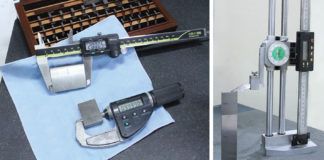“I cant build a plane! I don’t have a workshop, and even if I had the tools I don’t have the space!” Or so goes the lament as you walk away from the airport, head low and feet shuffling in abject surrender (include sound of can being kicked).
First, remember that “defeat” is where you put your shoes, and “denial” is just a river in Egypt. Proof? How about several builders whove built RVs in their apartments? While that example is a bit extreme, it does illustrate what can be done when tenacity and grit combine with ingenuity, perseverance and tolerant neighbors.
But where to start? Its sort of like eating an elephant…you do it one bite at a time. After all, many successful builders will admit that they might not have finished the project had they really kept the end-goal in sight every day. Build an airplane? Its too daunting a task. Better that you concentrate on todays task, e.g. “Im building an aileron.” Its a much smaller bite.
Similarly, building a shop is a bite-at-a-time project. Unlike eating an elephant, however, a shop has no end goal. Its more like going fishing. “When will you be done?” is never the question. Attitude is everything. So, with a recalibrated sense of the possible, lets take a look at where to begin, not whether to.
Where to Put It All
By where, Im not talking about the geography. No, its easier than that. Just decide on your medium such as aluminum, composites or fabric, buy the basic tools, a beginners kit such as the tail, and diddle around with it instead of watching television. You don’t have to lay out a miniature version of Burt Rutans Scaled Composites.
But the first project in any really good shop should be a really organized shop. I don’t mean just putting tools away, though thats important, but rather having an efficiently arranged shop. Without that, you’re just emulating Sisyphus, that poor schmo who the Greek gods condemned to rolling a boulder to the top of a mountain only to find it back at the bottom each morning.
While an apartment is a tough way to start building a project, a one-car garage is eminently workable. In fact, it can be easier than a two-car garage if you have to share it with a car. With a one-car garage you get, assuming the car is outside, all the walls. In a two-car garage with one car inside, you’ll have one wall fairly inaccessible.
No matter how many walls you have, there’s still the ceiling. A powered rafter table such as the RacorPro HeavyLift is a great way to store what you don’t need right now, but will need tomorrow or intermittently. Judicious shopping will allow you to acquire one for less than $130. Just use some caution when you load it down; you don’t want to have the ceiling on the floor.
Finished components such as a wing can go to one of those rental storage places where, for a reasonable fee, you can leave what you don’t need for a while. Just remember to throw a plastic sheet over it; even if the roof doesn’t leak, you don’t need a layer of dust that encourages corrosion.
Pegboard seems a tempting solution, but its not a favorite of mine. Those hooks are always coming off the board, even when theyve been captured by the little plastic clamps that are supposed to prevent it. Most tools should be stored in a roll-around toolbox. Longer tools, such as those long bar clamps, are OK on the pegboard, but nothing heavier than an electronic level ought to be entrusted to those fiberboard holes. You will need shelves, of course, so the type with their rails screwed to the wall studs is best.
If you decide to go for pegboard, remember that it has to be spaced out from the wall. He-who-shall-not-be-named once nailed it to drywall and then suffered the slings and arrows of innumerable base canards. “Yep, there’s a nut loose on both ends of every one of your wrenches” and “Interesting wall art you got there!” Adding insult to injury, I had been quite proud of the accuracy with which the nails were centered on the studs. The only solution was to get another sheet of larger pegboard and go over the first-after the spacing strips were installed.
As for roll-around toolboxes, you can go for one with a workbench built on top, but they cost $3500 and up! And you’re likely working in a small area, so heavy-duty, large-diameter wheels for easy rolling around is not critical. A $200 box from Sears has served me well for the last 30 years. Instead, build a workbench that fits tightly against one side of the garage. For instance, if you have a side door into the garage, place the toolbox next to it and then build the bench to fit the remaining space.
The Workbench
“Where can I get a good set of plans for a workbench?” My answer to that is, “Your own imagination.” Those generic plansbuilt benches are usually too low, too short in the left-right dimension and too deep to allow a car in the garage when the project is finished.
Lets start by assuming you’re working in your garage. This is a stand-up bench, and its your bench, so put its height where its comfortable for you. If you have a shorter toolbox, you’ll find that a bench that just goes over the top of the box is perfect. The best way to start is to roll the toolbox into place against the wall, then scribe a line on the wall about an inch above it. Now screw a couple of blocks against the wall with their upper edges just touching the line. Youll remove these later, so one screw in each is fine.
Next, measure the distance from the wall to the edge of the garage door; thats the depth of the bench. Finally, park the car and make a mark on the wall in line with the leading edge of the drivers door; thats the maximum length of the bench. Use the leading edge as your limiter, because you’ll need room to swing the door plus a little clearance.
You now have the length and depth of the workbench, so cut -inch plywood to that size. If you cant get a 4×8-foot sheet into your Mini Cooper, places like Home Depot will cut it to size. The 2x4s on edge will be the framework underneath, so cut them to go the full length of the plywood and a couple of inches shorter than the width of the plywood; this is to give you a cantilevered edge along the front of the finished bench. Youll need that lip for clamping things along the front, but you wont need it on the back or ends, so extend the frame out all the way. Depending on the size of the plywood deck, you might add a couple of cross braces between the front and back parts of the frame. Line those up with the wall studs.
You’re supporting the back of the bench by screwing it to the wall, so just put the bench on a 1-inch spacer on top of the toolbox, position the back edge on those blocks you put on the wall, and then screw the bench frame to one of the wall studs.
Now, check the bench for level, adjust it with shims between the bench frame and the toolbox, and add a couple of screws to the back of the frame on the wall. You’ve still got it on the toolbox, so run 2x4s diagonally down from the front of the frame down to the wall studs, stopping above the floor to make sweeping easy.
If you use vertical legs, you have to support the lower ends with a horizontal 2×4. Thats a good start for a shelf, but it prevents putting anything under the bench that wont fit on that shelf, such as a compressor.
Buy a box of deck-screws to assemble it all. One brand includes a bright blue Phillips bit thats a perfect fit and really makes it easy, especially if you include a neat little $2 tool that captures the bit and the screw in an extendable sleeve.
A nice aid would be to add a power strip under the bench. This way you don’t have the cords draped over the workspace. If you can also add a shelf under the bench, you’ll have a place to store the corded tools. Don’t forget to size the shelf so that the compressor can be removed without knocking a hole in the garage wall. (No, I did not make that mistake.)
If you have room, put the bench on wheels. A couple of clamps will allow you stabilize it against the wall. This would work for a small shop, and might be even more useful in a limited space situation.
Of course, you cant put the compressor under this configuration if the front legs are vertical, but thats one of the trade-offs. When I was in a one-car, and later two-car garage, I had the compressor under the bench. Now that I have a hangar, there’s room for a big, vertical compressor, so I use the roll-around configuration.
The Compressor
Youll probably want to buy a compressor right now to size the bench. Dont. Buy the air tools you’ll need. Those cheap-o kits are, surprise, perfectly fine for the homebuilder. Just remember to put three drops of oil directly into the air inlet right before using them, and theyll give good service.
Once those tools are in the box, check for the one that uses the most air. The pressure is not really the issue here; its the cubic feet per minute (CFM) rating that sizes the compressor. An insufficient compressor makes about as much sense as a cow in a track suit.
If you choose to put the compressor under the bench, it wont be the vertical type. That doesn’t mean it has to be low capacity or noise cursed. Reliability and noise can be kept under control by buying a piston-type compressor. Its no small issue if the neighbors start complaining that you’re more annoying than those mega-watt automobile systems, so have your spouse go with you for a racket check.
If you’re stuck with a really noisy beast, the compressor, that is, you can construct a plywood box around it and line it with foam. If it has anywhere near the CFM capacity you want, it wont overheat in the low-cycle use you’ll give it. This worked fine for the one-car condo garage I used to have.
Remember that any holes will leak noise in copious amounts. To appreciate this, consider that a 1-cubic-foot box with perfect insulation allows 90% of the noise to escape if the box has only a 1-square-inch hole. If you don’t believe it, consider the noise reduction that occurs when you close the laundry-room door that last eighth of an inch.
You’re also probably tempted to install an in-line oiler. Again, dont. Youll coat the air lines with oil and wind up spraying oil on the working surfaces. You should, however, install an air dryer in the line. You can add a couple of drops of oil into the inlet of the tool to make up for the loss of the oiler, but a couple of drops of water through the tool can destroy it in short order.
One last item here is the hose. First, skip that coiled hose; it just gets hooked on everything. Self-retracting hoses are nice, but they can also be a nuisance, as they’re usually too short, too small or too expensive. The cheaper plastic hose is usually bright orange and costs about $10. But its stiff, especially when its cold. Buy only 3/8-inch inner diameter rubber hose for about $35, and you’ll be a lot happier. If you want to set this up right, visit your local paint supplier for advice. He probably has a schematic of an air system for a paint shop that will show some great ideas on pipe sizing and water traps.
Shelf Life
Shelves are critical, and you cant have too many…well, yes, you can. Leave a space on the wall for drawings if they’re the big C and D size, or build an angled shelf to hold the binder open. That way its not using your precious bench space. Heres one place where pegboard and long wire shelf supports are useful; just bend the supports down to a reading angle, and then put a hook in the end to keep the binder in place.
The shelves that you do build should be strong enough to support the weight of several gallons of paint. The upper shelf should be 8 inches deep, and the lower 12 inches. Any deeper, and you’ll lose your materials to the back of the shelf upper. Those vertical metal brackets with adjustable shelves work well. Just make sure you screw them into the studs and not into drywall. A $20 stud-finder is perfect for finding the studs with far greater accuracy than knuckles rapping on drywall.
Similarly, you don’t need a deep bench for the smaller bench-mounted tools such as grinders and belt sanders. You don’t want anything stored in the vicinity, because it will be covered in grinding wheel dirt, so be sure to give them a separate home.
On those narrow benches you should mount a bench grinder with an aluminum-cutting wheel. Youll need this no matter what medium your chosen project is built of, as they all require plenty of aluminum. Right now you’re probably saying, “Hes got plenty of room for all those benches!” But in fact I set up most of these small benches around the one-car condo garage where I built 90% of my RV-6.
Youll also want a 1-inch belt sander with a supply of extra belts. A buddy of mine refers to his as his “belted milling machine.” But its often mated to a rarely used 5-inch disk sander, so don’t take up the space with one if you have a choice.
What you should find wall space for is your collection of metal files. Don’t put them in a drawer! Take a close look at the teeth on a new file and compare it to one thats been tossed into the drawer with other files. The latter will have shiny spots on the surface, which are dulled teeth caused by banging a hard edge against a hard edge.
You wont be surprised to learn that I still do not recommend pegboard for this application. No, take a look at a similar problem in the kitchen: You don’t toss those big-bucks Henckel knives in with the Sabatier stuff do you? Not if want them to stay sharp, you dont. Wood blocks are fine for knives if you have the counter space, but a magnetic strip works better. It works for files, too, as long as the magnet is good. Cheap strips are not likely to have the necessary holding power, so take your largest file into the kitchen supply store and try it out.
Last on the list should be three catalogs: Aircraft Spruce, Enco and Harbor Freight. And one more thing. If you’re like me, you can hang up a sign that says: “If it cant be fixed with a hammer, its an electrical problem.”
Wed like to hear about your solutions to the space issue. Do you have a good tool or technique that makes you smile when you think of it? Send a photo and a description to [email protected]. The smile is fine, too.




